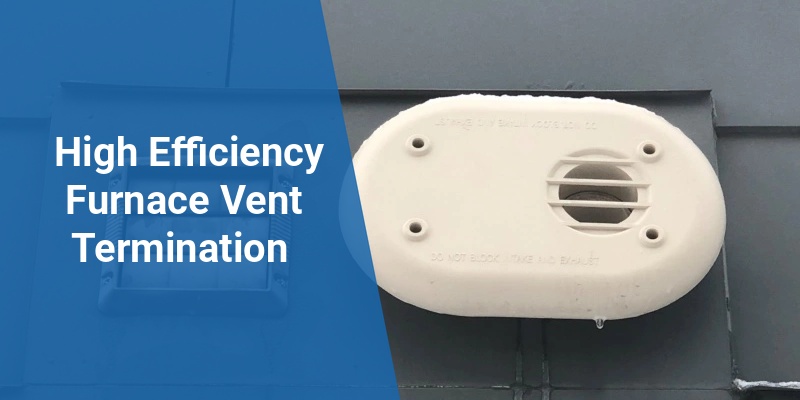High efficiency furnaces are popular in American homes due to their ability to reduce energy consumption and lower heating costs. However, proper vent termination is crucial to ensure safety, efficiency, and compliance with building codes. This article covers everything homeowners and professionals need to know about high efficiency furnace vent termination, including vent types, placement guidelines, code requirements, and maintenance tips.
| Topic | Key Points |
|---|---|
| Vent Types | PVC, CPVC, and Stainless Steel |
| Termination Location | Clearances, outdoors placement, and distance from openings |
| Code Compliance | International Residential Code (IRC), Manufacturer requirements |
| Maintenance | Inspection, cleaning, and damage prevention |
What Is High Efficiency Furnace Vent Termination?
High efficiency furnace vent termination refers to the section of the venting system where exhaust gases from a furnace exit the building. Modern high efficiency furnaces use sealed combustion that requires special vent pipes to safely remove condensation and combustion byproducts. Proper termination ensures that exhaust gases are vented safely away from windows, doors, and air intakes, minimizing health risks and improving appliance longevity.
Types of Vent Materials and Their Applications
High efficiency furnaces produce cooler exhaust compared to older models, which allows the use of different vent pipe materials:
- PVC (Polyvinyl Chloride): Common for vent pipes due to durability, corrosion resistance, and cost-effectiveness.
- CPVC (Chlorinated Polyvinyl Chloride): Similar to PVC but better suited for higher temperature exhaust gases.
- Stainless Steel: Used for venting when codes or manufacturers require metal due to heat concerns or durability needs.
Selection depends on furnace specifications and local code requirements. Using approved materials for vent termination avoids safety hazards and extends furnace life.
Proper Placement and Clearance for Vent Termination
Correct termination placement is vital for avoiding exhaust gas re-entrainment and ensuring safe operation. The International Residential Code (IRC) outlines minimum clearance distances to objects and openings. Key guidelines include:
- Distance from Doors and Windows: Vent terminations must be at least 3 feet away horizontally from any door, window, or fresh air intake.
- Height Above Ground: The vent should terminate at least 12 inches above adjacent grade level to prevent blockage by snow or debris.
- Distance from Combustible Materials: Maintain adequate clearance—often 6 to 12 inches depending on vent material—to nearby combustible surfaces.
- Outdoor Air Intakes: Position vent terminations downwind or as far as possible to avoid exhaust gases entering fresh air intakes.
Failure to meet these clearances can lead to carbon monoxide risk and decreased furnace efficiency.
Building Codes and Manufacturer Requirements
Compliance with local building codes and manufacturer instructions is non-negotiable for safe and legal furnace installation. The International Residential Code (IRC) provides baseline standards for high efficiency furnace venting in most U.S. jurisdictions.
Call 888-906-9139 for Free Local HVAC Quotes – No Obligation, Just Savings!
- Codes specify vent pipe sizing rules, slope requirements to prevent condensation buildup, and termination locations.
- Manufacturers provide specific vent kit requirements and maximum allowable vent lengths for optimal performance.
- Local amendments might impose stricter rules, so installers should verify with local building departments.
Adhering to these guidelines guarantees safe, efficient operation and protects warranties.
Installation Best Practices for High Efficiency Furnace Vent Termination
Professional installation is recommended to ensure vent termination meets all codes and performs efficiently. Best practices include:
- Using proper vent materials as per furnace rating and code.
- Maintaining vent pipe slope—typically 1/4 inch per foot—toward the furnace to drain condensate safely.
- Sealing all pipe joints to prevent exhaust leakage.
- Mounting vent termination securely using manufacturer-recommended brackets and supports.
- Positioning termination to minimize exposure to wind-driven rain or snow intrusion.
These steps increase furnace lifespan and protect indoor air quality.
Common Issues and Troubleshooting
Several common problems relate to improper vent termination:
- Condensate Drainage Problems: Incorrect slope causes water buildup and pipe corrosion.
- Blocked Vent Terminals: Snow, ice, or debris can obstruct exhaust flow.
- Improper Clearance: Exhaust gases entering building due to close proximity to windows or fresh air intakes.
- Vent Pipe Damage: Cracks or loose joints leading to leaks of hazardous gases.
Regular inspection and maintenance prevent these issues.
Maintenance and Inspection Recommendations
Routine furnace vent terminal inspection is critical to ensure ongoing safety and efficiency:
- Check vent termination for blockages, corrosion, or damage at least annually, ideally before the heating season.
- Clear away snow accumulation promptly during winter.
- Verify seal integrity of vent joints and replace worn components as needed.
- Hire certified HVAC professionals for thorough inspections and maintenance.
These efforts reduce carbon monoxide risks and improve furnace reliability.
Call 888-906-9139 for Free Local HVAC Quotes – No Obligation, Just Savings!
